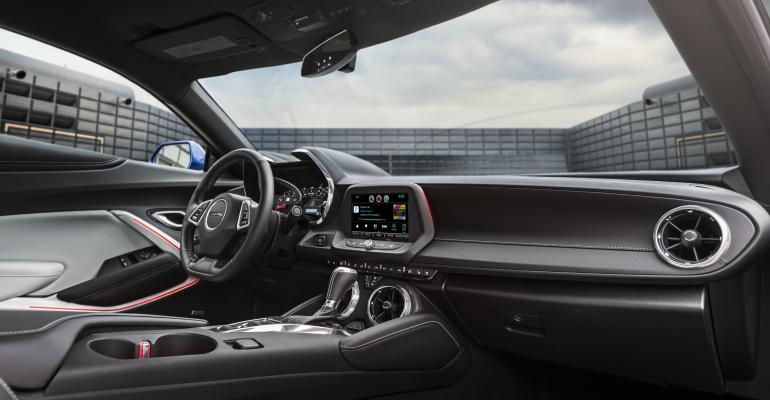Wards 10 Best Interiors competition has recognized outstanding automotive interiors for six years. This installment is part of a series of interior deep dives following in the footsteps of “The Story Behind the Wards 10 Best Engines.”
The 2017 10 Best Interiors winners will be announced in April and on display at the WardsAuto Interiors Conference May 9 at Detroit’s Cobo Center.
It is fitting, WardsAuto editors say, that the Chevy Camaro boasts a cabin as pleasing and sophisticated as its chassis and powertrain, which has not always been the case.
It impressed them with its handsome, body-hugging seats, its classy brushed-metal-like trim, the driver-friendly ergonomics of its seating, shifter and steering wheel positioning, its easy-to-use infotainment touchscreen and hard controls. And the judges especially liked the dual HVAC temperature adjusters cleverly integrated into the large central air vents.
The primary mission, according to Ryan Vaughan, director of design-Chevrolet Car, Crossover and Performance Interiors, was to “reinterpret Camaro heritage in a modern way” by striking the best possible balance between heritage design and modernity. Also, “knowing the new platform would be so capable from a performance point of view, we wanted to make sure the driving environment was as ergonomic as possible.”
So the first major challenge was creating a design that was instantly recognizable as a Camaro but “new and cool” at the same time.
“We did a lot of sketching and invited sketches from our other studios around the world to cast as wide a net as possible to find that new look. It was a tricky balance,” Vaughan says.
Also challenging was packaging everything into the lighter and more compact sixth-generation Camaro.
“We had less space to play in,” Vaughan says. “It required us to find some different solutions in how we laid out the design and executed all the componentry. We wanted to make sure it still felt wide and powerful, so we looked at designs that would emphasize the width and push the instrument panel out to the doors as far as we could.”
Another priority was ensuring driver touch points were soft and accommodating. “Improving material quality was a huge push,” Vaughan says. “We can’t wrap everything in leather; it’s too expensive, and we don’t want to price it out of reach. So we put premium materials where we would get the most value from them. If you design with that approach from the beginning, you can make it look integrated and cohesive. And all of those soft pieces are cut-and-sew wraps. You can see how they are constructed and fit together, and seeing that craftsmanship on display has a lot of visual value.”
One strong feature (similar in concept to the Audi TT’s) is the dual HVAC temperature controls integrated into decorative rings around the central vents. Consolidating the vents and their controls makes the whole unit smaller and it fits under the touchscreen forward of the shifter.
But that presented an engineering challenge. Temperature control knobs use optical encoders to send signals to the HVAC computer, and this design required larger optical encoders than ever before. The encoders also must be well-sealed and protected, since pumping cold air-conditioned air into a humid environment can result in condensation.
“We did a lot of testing to make sure the electronics were completely sealed and protected,” Vaughan explains. “That made people nervous, but we got through it. We also did a lot of ergonomic testing to be sure the ring was not too big or uncomfortable to use, that it could be operated precisely on a bumpy road and that it took the right amount of effort. We made a mockup that we tuned to different efforts and detent styles, from sharp to smooth.”
Another improvement is the electric park brake, unusual in this segment, which replaces the previous Camaro’s parking brake lever to free up console space.
“In the fifth-generation car, the cupholders are on the centerline of the console behind the shifter,” he says, “so anything in them gets in the way of shifting, which is important in a car like this. So replacing that brake lever with a little switch allowed us to push the cupholders over to the passenger side so the driver has a clean reach to the shifter without being impeded by anything in the cupholder. It also gives the driver a usable armrest, which was missing in the previous car.”
Will this interior inspire others down the road?
“Yes,” Vaughan predicts. “Without getting into specifics of future products, the Camaro and Corvette kind of set the tone for Chevrolet, not in exact ways, but in spirit. And some of the details will influence future designs.”




